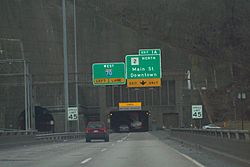Wheeling Tunnel facts for kids
 |
|
| Westbound tunnel entrance | |
| Overview | |
|---|---|
| Location | Wheeling, West Virginia |
| Coordinates | 40°04′22″N 80°43′11″W / 40.0727192°N 80.719621°W |
| Route | |
| Operation | |
| Work begun | August 22, 1963 |
| Operator | WVDOH |
| Vehicles per day | 59,600 (2009 AADT) |
| Technical | |
| Length | 0.27 mi (430 m) |
| Number of lanes | 2 each |
| Operating speed | 45 mph (72 km/h) |
The Wheeling Tunnel is made of two separate tunnels in Wheeling, West Virginia. It helps Interstate 70 and U.S. Route 250 pass through a large hill called Wheeling Hill. Each tunnel has two lanes for cars and trucks.
The West Virginia Division of Highways manages the tunnel. It opened in 1966 and cost about $6.9 million to build. Later, between 2007 and 2010, it was updated for $13.7 million. In 2009, around 59,600 vehicles used the tunnel every day.
Contents
What is the Wheeling Tunnel?
The Wheeling Tunnel is located between exits 1A and 1B on Interstate 70 and U.S. Route 250. These highways share the same path through Wheeling. They use the tunnel to get through Wheeling Hill.
Drivers who need to take exit 1A at the west end of the tunnels use the right lanes. These lanes help them speed up or slow down safely. It is important to know that changing lanes inside the tunnel is not allowed.
Why were there concerns about trucks?
Some accidents involving large semi-trailer trucks happened in the tunnel. Because of this, local leaders wanted to stop trucks from using the tunnel. They suggested that trucks use a different highway, I-470, instead.
How was the Wheeling Tunnel built?
Building the Wheeling Tunnel was a big project. Workers used 13,000 square feet (1,200 square meters) of special tiles to cover the inside walls. The tunnel cost $6.9 million to build back then.
Construction started on August 22, 1963. The governor of West Virginia at the time, William Wallace Barron, helped begin the work. He said it was the biggest building project for the state's Interstate Highway program. A company from Baltimore, Maryland, called C.J. Langenfelder & Son, Inc., was hired to build it.
What challenges did workers face?
During construction, some workers became sick from breathing too much carbon monoxide. This gas can be dangerous. Because of this, the company stopped working in 1964. They waited until large fans were installed to make sure the air was safe. The tunnel officially opened to traffic on December 7, 1966.
Why was the tunnel rebuilt?
The West Virginia Division of Highways started planning to update the tunnel in 2005. The actual rebuilding work began in January 2007. The plan was to finish in three months. However, fixing the eastbound tunnel took much longer, over eleven months.
What problems caused delays?
There were several issues that slowed down the project:
- The glue holding the tiles to the tunnel walls had problems.
- The drains inside the tunnel also caused delays.
- Workers even found an old coal mine inside the tunnel, which was unexpected and caused more delays.
Because of these problems, some local officials thought about closing the tunnels completely. They considered building a new road over Wheeling Hill instead. However, building this new road would have meant that about fifty families would lose their homes. The National Association for the Advancement of Colored People (NAACP) spoke out against this plan because it would harm those families. The state then decided not to build the new road.
When was the rebuilding finished?
Work on the eastbound tunnel started again in July 2008. While the eastbound tunnel was being fixed, the westbound tunnel was only closed overnight for its updates. New guard rails, fire sprinklers, and security cameras were added to both tunnels. The entire tunnel was also cleaned very well.
Workers put a new road surface inside the tunnel. A company from Germany replaced the tiles. This German company was chosen because no other company could finish the work on time. The eastbound tunnel was finished on October 31, 2008. The westbound tunnel closed in February 2010 and opened earlier than planned in September 2010. Because of all the delays, the total cost of the project was more than double the original plan, reaching $13.7 million.
Images for kids


